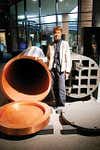Finnish Company Claims Its Copper Canisters Can Store Nuclear Waste for 100,000 Years
While the fate of America’s Yucca Mountain appears to be sealed, Finnish company Posiva is moving forward with a cutting-edge...
While the fate of America’s Yucca Mountain appears to be sealed, Finnish company Posiva is moving forward with a cutting-edge nuclear waste storage facility that it claims will safely store radioactive waste in drums deep in the ground for 100,000 years. While challenges abound, a green light from the Finnish government expected by 2012 will make the site on Finland’s Olkiluoto Island the first permanent nuclear waste repository in the world, opening the door for more to follow.
The task is not a small one, however. First, Posiva carved nearly 16,500 feet of tunnels, collecting borehole samples along the way to ensure that the bedrock is solid and that water — a nuclear waste repository’s biggest enemy — cannot get in. Then they had to figure out how to create the nearly 29-ton copper storage bins lined with iron and sealed with a weld so precise that it will hold through Finland’s next ice age.

The Copper Canisters
Oh, and naturally they must execute that precision weld after placing highly radioactive fuel rods inside, rendering the drums untouchable.
To make it all work, Posiva’s engineers came up with a unique system. Bundles of rods will be delivered in special transit bins to a sealed room in the facility. A robot arm, controlled remotely via a video link, will remove the fuel bundles and dry them — remember, absolutely no water can go into storage with the rods — before placing the extremely hot cargo into the copper canisters.
While moving the rods is the most dangerous part, sealing them in their bins is by far the hardest. To make sure the welds are perfect — and to last 100,000 years, they have to be — the engineers are designing a kind of conveyor belt that allows the drums to swivel and turn as they move. As each bin rotates precisely, high-velocity electrons bombard the seal between lid and canister, fusing the cask with a strong weld without weakening the surrounding material. Any flaws or weak spots in the welding seam will be caught at the end of the track, where X-ray, ultrasonic and eddy-current inspection devices check the seam for imperfections.
If all goes to plan and the government approves Posiva’s ambitious plan, the Olkiluoto facility will be in business by 2020. But by proving the technology works, Posiva won’t just earn the right to a contract for 100 years of nuclear storage; it will have demonstrated to the world that indeed such facilities are possible, perhaps resurrecting abandoned projects like Yucca Mountain and pushing nuclear energy to new prominence. Right now, it starts with a perfect weld seam — check back in 100,000 and we’ll tell you how it ends.